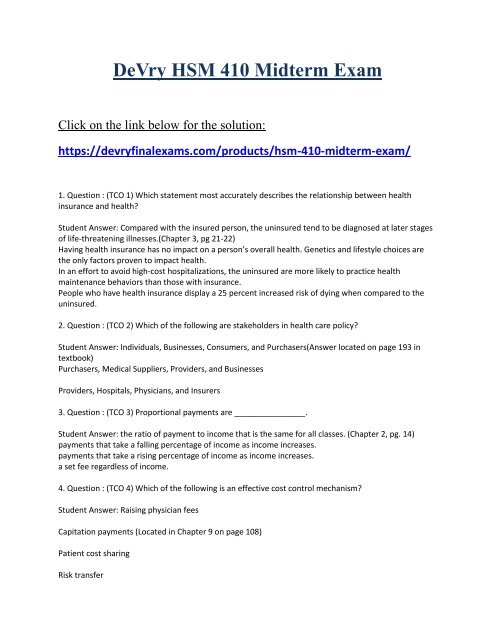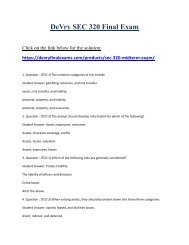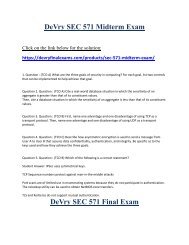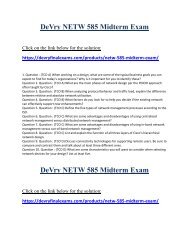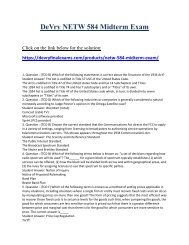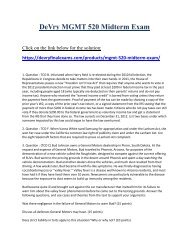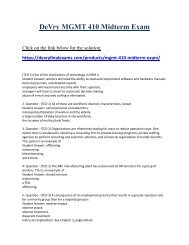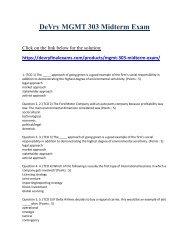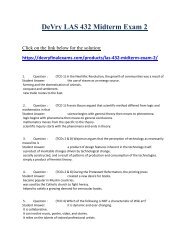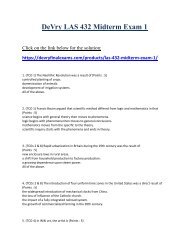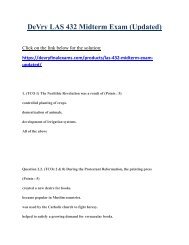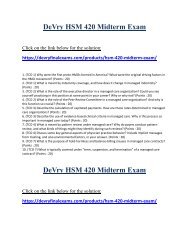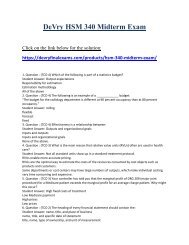HSM 410 Midterm Exam
You also want an ePaper? Increase the reach of your titles
YUMPU automatically turns print PDFs into web optimized ePapers that Google loves.
DeVry <strong>HSM</strong> <strong>410</strong> <strong>Midterm</strong> <strong>Exam</strong><br />
Click on the link below for the solution:<br />
https://devryfinalexams.com/products/hsm-<strong>410</strong>-midterm-exam/<br />
1. Question : (TCO 1) Which statement most accurately describes the relationship between health<br />
insurance and health?<br />
Student Answer: Compared with the insured person, the uninsured tend to be diagnosed at later stages<br />
of life-threatening illnesses.(Chapter 3, pg 21-22)<br />
Having health insurance has no impact on a person’s overall health. Genetics and lifestyle choices are<br />
the only factors proven to impact health.<br />
In an effort to avoid high-cost hospitalizations, the uninsured are more likely to practice health<br />
maintenance behaviors than those with insurance.<br />
People who have health insurance display a 25 percent increased risk of dying when compared to the<br />
uninsured.<br />
2. Question : (TCO 2) Which of the following are stakeholders in health care policy?<br />
Student Answer: Individuals, Businesses, Consumers, and Purchasers(Answer located on page 193 in<br />
textbook)<br />
Purchasers, Medical Suppliers, Providers, and Businesses<br />
Providers, Hospitals, Physicians, and Insurers<br />
3. Question : (TCO 3) Proportional payments are ________________.<br />
Student Answer: the ratio of payment to income that is the same for all classes. (Chapter 2, pg. 14)<br />
payments that take a falling percentage of income as income increases.<br />
payments that take a rising percentage of income as income increases.<br />
a set fee regardless of income.<br />
4. Question : (TCO 4) Which of the following is an effective cost control mechanism?<br />
Student Answer: Raising physician fees<br />
Capitation payments (Located in Chapter 9 on page 108)<br />
Patient cost sharing<br />
Risk transfer
5. Question : (TCO 1) How is Health Policy Formed?<br />
Student Answer: Through discussion with patients<br />
Through the judicial system<br />
Through the legislative process<br />
Both B and C (Week 1 Lecture)<br />
6. Question : (TCO 3) Which of the following are modes of paying for health care?<br />
Student Answer: Capitation, Fee-for-service, and Salary<br />
Out-of-pocket payments, individual private insurance, employment-based private insurance, and<br />
government financing (Chapter 2, pg 5)<br />
Private Insurance and government financing<br />
Medicare, Medicaid, Private Insurance<br />
1. Question : (TCO 2) What were the most common medical care structures of the first half of the<br />
twentieth century?<br />
2. Question : (TCO 4) List the methods of physician payment.<br />
3. Question : (TCO 2) What are the three models of organizing care? Provide a brief description of the<br />
care provided at each level.<br />
4. Question : (TCO 4) What is the concept of patient cost sharing? Is it painless form of cost control? For<br />
whom?<br />
5. Question : (TCO 3) Describe why private health insurance coverage has decreased over the past<br />
decades, creating the uninsured/under insured crisis? Who are the uninsured?<br />
DeVry <strong>HSM</strong> <strong>410</strong> <strong>Midterm</strong> <strong>Exam</strong><br />
Click on the link below for the solution:<br />
https://devryfinalexams.com/products/hsm-<strong>410</strong>-midterm-exam/


